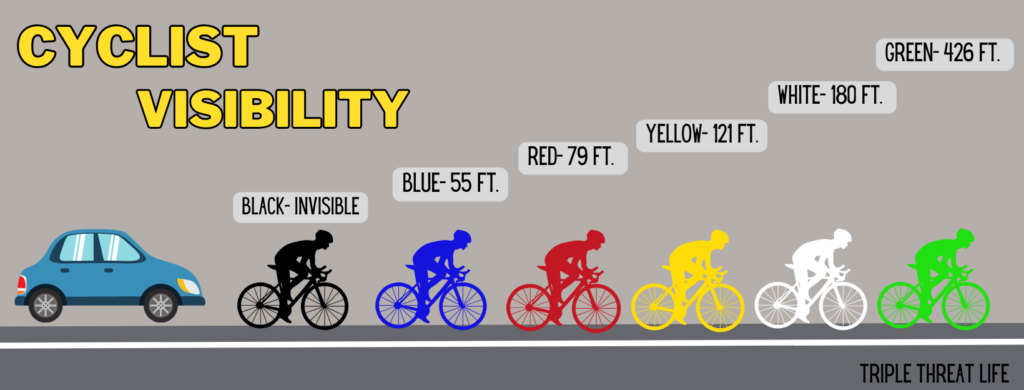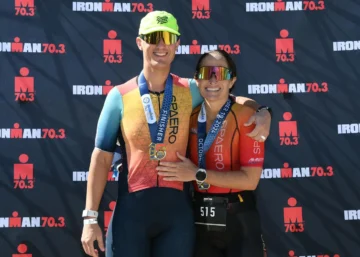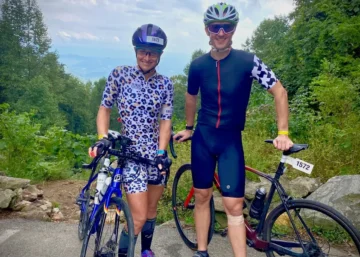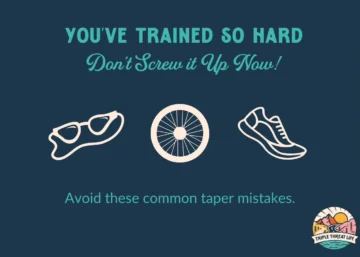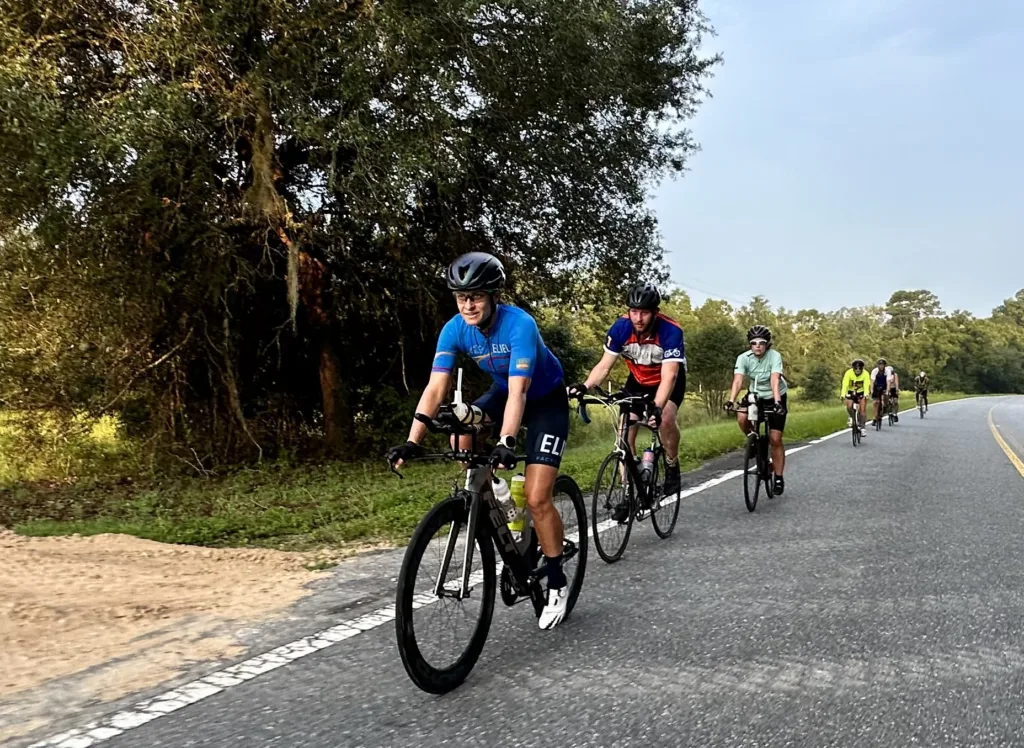
Riding in a group is an integral part of becoming a better cyclist, and triathlete. But if you’re a beginner, riding with a group can be a bit intimidating.
Now that many triathletes are getting back on the road to prep for race season, it’s the perfect time to review group ride guidelines. There can be great benefits to riding in a group, but there are some risks as well, and safe group riding require some basic etiquette.
Benefits of riding in a group
The most obvious benefit of riding in a group is safety. Unless you’re riding on a dedicated bike trail, you will encounter cars, passing traffic, intersections, and stop lights. Someone driving a car is much more likely to see a group of 10 cyclists than one cyclist riding alone. Also, if something were to happen, like a mechanical, a flat tire, or an accident, there’s a group of people to back you up. Never. Ride. Alone.
Another benefit to riding in a group is that you will become a stronger and more skilled cyclist. Even during a steady ride, there will be variable and unpredictable intensity, which builds strength. Also, riding in close proximity to others helps improve handling skills and reaction time.
Typically, when riding in a group, you’re going to ride faster than you would on your own. Even with the benefits of a draft, you still have to recruit muscle fibers to pedal at a higher cadence and express more power, which helps you learn what it feels like to do that when you’re riding solo, like during a race.
For most people, the biggest draw of group rides is the social aspect. Especially when training for a long distance triathlon, like a 70.3 or Ironman, riding with a group can provide motivation, accountability, and camaraderie. And it’s just more fun to ride with friends!
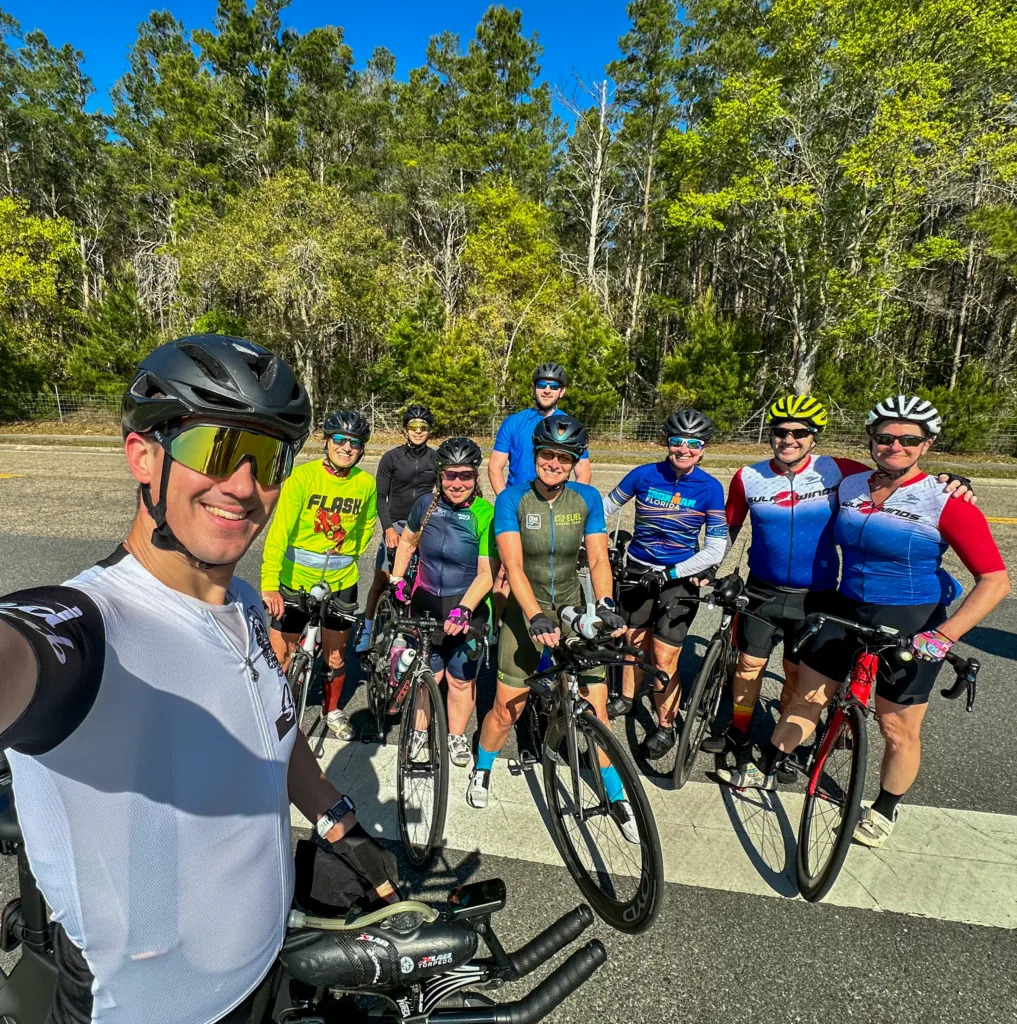
There’s a saying,”If you want to go fast, go alone. If you want to go far, go together.” But that’s not entirely true when it comes to group rides… You can go faster AND farther together!
Group ride expectations
Before you show up to a group ride, make sure you’re prepared. Know the estimated pace, distance, and download the map, if there’s one. It’s your responsibility to know where you’re going. Also, make sure you bring enough hydration and nutrition for the ride’s duration, as well as a tire change kit, tail light, and all your gear- helmet, cycling shoes, gloves, sunglasses, ect.
Not all group rides are created equal, so know the expectation ahead of time. Is this a group that’s going to wait for you at a stoplight, or is it a group that’s going to leave you behind if you get a flat? The first will be called a no-drop ride, while the latter will be called a drop-ride (although I have another word for it, but I digress).
As far as pacing, my personal group doesn’t use the old-fashioned method of A, B, C for rating rides. Instead, we provide estimated mph. For example, we might say 18-19 mph for 40 miles. But keep in mind that you will always ride faster in a group than you will on your own. So if you can confidently ride 17 mph, don’t be afraid to join the 18-19 mph group.
Something unique we do on our group rides is we have designated areas for “efforts” or “pickups.” We pick a safe section of road with no traffic that ends at a stop sign so riders of different paces can separate and do their own race-pace intervals. Then, we all meet up at the end. It’s a great way to incorporate intensity and complete your workout, while also getting the benefits of a group ride.
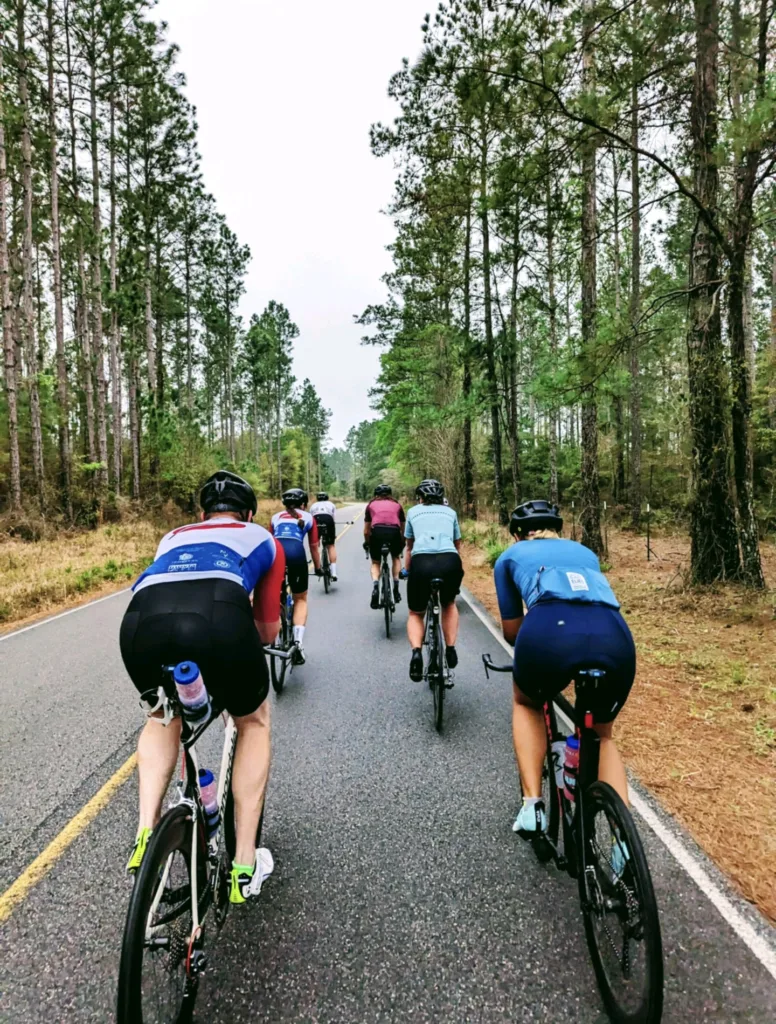
How a pace line works
Most groups ride in a pace line where cyclists ride single file in one line, or two lines where cyclists ride side by side. The rider in the front takes most of the wind and sets the pace for the group. Those who ride behind will benefit from a draft, which can be as much as 50% in wind reduction.
When the lead rider is done pulling at the front, that person will look over their left shoulder and rotate off the line to the left. This lets the rider who’s second in line know that it’s time to take their turn at the front.
The rider who’s pulling through shouldn’t surge, just maintain the same pace. The original lead rider backs off the pace until they get to the back of the line and falls in behind the last rider. It’s a counter clockwise motion and, if done correctly, is a very smooth and efficient way to share the workload.
Sometimes a strong rider will just stay on the front and set a manageable pace that everyone can sustain for a longer period of time. In this case, simply sit on the back and benefit from the draft. If you’re in the front, you’re responsible for picking a safe path down the road that’s clear of obstacles.
More experienced riders will maintain one to two wheels length of distance between bikes, but a beginner might use 1-2 bike lengths. Whatever distance you choose, know that you’re responsible for your own front wheel. If you touch someone’s back wheel, you’re going down, not them.
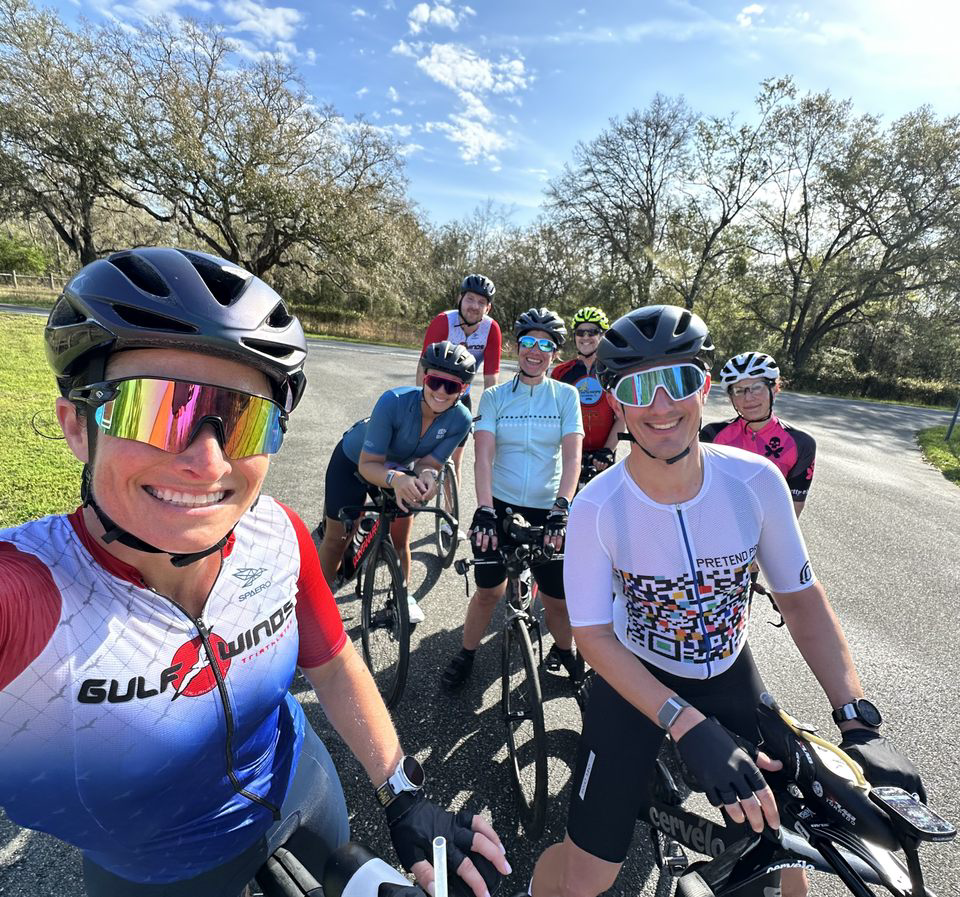
Hand signals and verbal cues
During a group ride, not only are you responsible for your front wheel, but also for everyone who’s riding behind you. Think about that the next time you go on a group ride. Every person who’s behind you is relying on your judgement to help keep them safe, so there’s an element of trust when it comes to riding in a group. The further back you are in a pace line, the harder it is to see upcoming obstacles.
That’s why we use hand signals and call out warnings to other riders. Cyclists do this in different ways, so it’s good to also yell, “slowing!” or “stopping!” along with the hand signal. Other verbal cues include “car up,” “car back,” or “passing” to let riders know of an approaching vehicle. You can also use self-explanatory cues like “hole,” “dog,” “gravel,” ect. “Clear” is used to indicate an open intersection, but still visually double check before you go through the stop sign.
An open palm or closed fist held to the back indicates an upcoming stop. An open palm held to the back with a patting or dribbling motion means you should slow down.
A flat palm directed to the side that waves back and forth means gravel or sand on the roadside. You should point at large debris, like pothole, sticks, or rocks. Other gestures include a behind the back sweeping movement to indicate that cyclists should move over and a raised hand for a mechanical or hard stop due to a problem.
The key thing to remember with signaling is that it only works when everyone does it. Remember the telephone game you played when you were a kid? You pick a phrase and whisper it to the next person until it goes all the way down the line. It’s the same in a group ride. If someone in the middle of the line decides not to participate, and doesn’t signal debris, then all of the riders behind that person don’t know what’s going on.
When you’re in a pace line, the person in front of you blocks your line of sight. So by the time you see something you need to avoid, it’s already too late, especially if you’re moving at a high rate of speed. The bottom line is that you’re responsible for passing warnings down the line. Don’t just assume a rider behind you is going to see debris. It’s irresponsible, and riders who cause crashes aren’t likely to be invited back on a group ride.
What NOT to do on a group ride
- Don’t half wheel- Half wheeling is when you let your front wheel overlap the back wheel of the rider in front of you. If that person has to move to the side and taps your wheel, you will go down and take out everyone behind you.
- Don’t coast- When you stop pedaling in a pace line, the rider behind you goes on alert. Are you about to slow down? Are you stopping? Is there a pothole? Also, it makes an annoying noise that irritates other riders. Always keep pedaling, just shift your gears and adjust your cadence so you can maintain the pace of the group.
- Don’t steer from your arm pads– This is a big pet peeve of mine. The arm pads on a triathlon bike are where you rest your forearms when you’re in the aero position. They’re not for steering. If you’re steering with your hands on your arm pads, and something happens in front of you, there isn’t enough time to move down to grab your brakes. When I ride in a pace line, I keep my hands on my hoods by my brakes. Then, when it’s my turn at the front, I get into my aero bars.
- Don’t pass on the right- If you need to pass a rider in front of you, pass on the left. Do not pass on the right. It’s just like if you were driving a car on a two lane road.
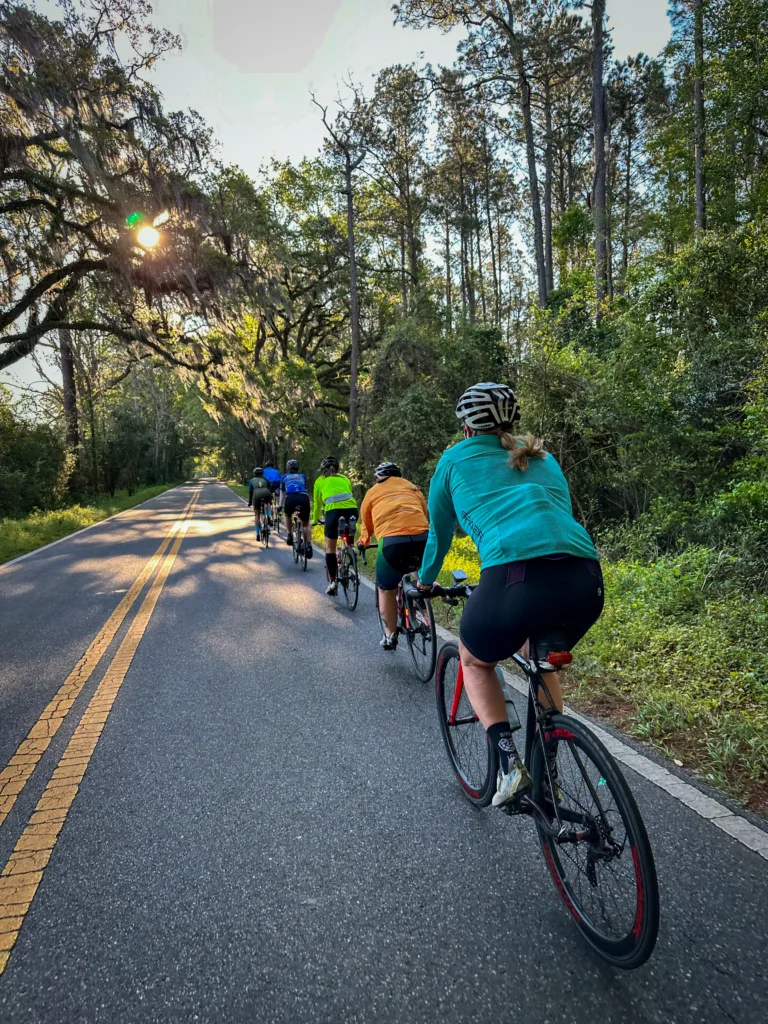
Find a group ride
Luckily, I live in a town with a lot of triathletes and cyclists, and my husband and I host our own group ride on the weekends. If you’re looking for a group ride in your area, there are a few things you can do.
First, ask your local bike shop. They should be able to connect you with a local group and direct you to a ride that will fit your ability and skill level. Also, search for any cycling or triathlon clubs in the area that might have training opportunities. Social media is helpful for finding these resources. If all else fails, start your own group! We did this via the GroupMe app, but you can do something similar with a Facebook group or group text.
Find a group ride that fits you and you have no idea how your triathlon training, and life, might change as a result!
